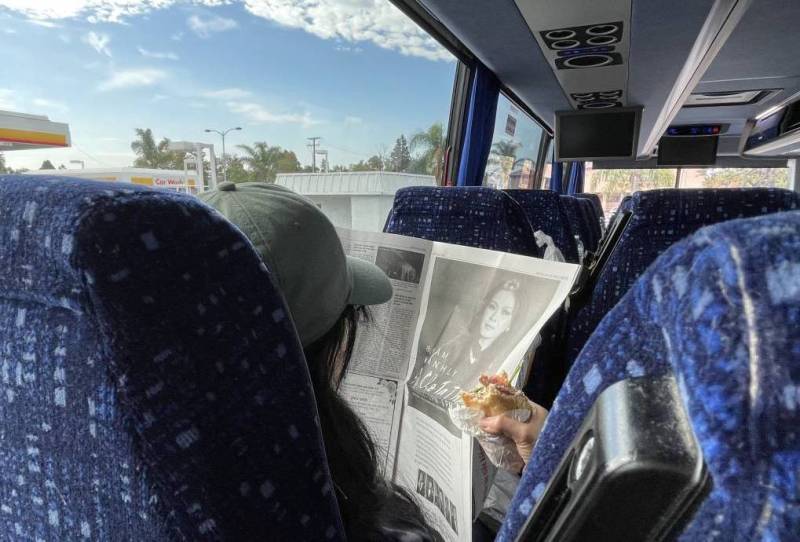The mention of a certain north-south bus line makes many Vietnamese Californians smile.
“The first time riding this bus, I was feeling like I was sitting in central Saigon's sidewalk. We ate Vietnamese sandwiches and watched a Vietnamese music show on TV,” wrote Hồng Cao, director of operations at the Việt Museum in San José, in a text. “People on the bus were so talkative. They exchanged all the news that happened in San Jose and in Orange County. You did not need to read the newspaper to know what was happening in your areas.”
SFO and LAX may be the largest airports in California, but two strip malls, one in East San José and another in Westminster, have also become transportation hubs, connecting the two largest Vietnamese communities outside Vietnam.
Since 1998, seniors, students, reluctant drivers and bargain hunters of all ethnicities have relied on the Xe Đò Hoàng bus line. Service runs from multiple Vietnamese commercial centers in California and Arizona, but the flagship route remains the one along Interstate 5 between San José and Westminster, the original Little Saigon.
Most major stops are near at least one shop selling bánh mì, the iconic Vietnamese sandwich: a baguette filled with grilled meat, cold cuts or pâté, pickled vegetables, herbs, chilis and proprietary seasonings. Before COVID, the on-bus service included a free bánh mì from a nearby shop. That’s how the line got its nickname: the bánh mì bus. Now, passengers bring their own food.
For the uninitiated, the first time at a Xe Đò Hoàng bus stop can bring feelings of uncertainty, especially because the white tour coaches have no logos and the stop has no signs.
“There will be no markings other than Asian people hanging out under the shade of the trees,” writes Penelope M. from Los Angeles in a Yelp review.
I had heard about the bus for years. My teenager loves to eat, and this summer, she requested a trip to Orange County to gorge at the weekend night market. I thought, why not go in real Viet style?
So early on a recent Thursday morning, we headed to an East San José strip mall. As the kind of mom who needs to ensure there’s enough to eat, I was relieved to find four bánh mì shops in a one-block radius. Kim’s Sandwiches has house-made mayonnaise, which, for me, earns it an extra star in ratings. We hurried to choose our on-board meal, because the bus leaves at exactly 8:30.
At the bus stop — on the corner of Burdette Drive and S. King Road — I spotted Asian people with reusable shopping bags and rolling luggage, just like “Penelope M.” promised. I was in the right place.
Tùng Đỗ, the driver, checked my name off his iPad. Reservations are available by phone or through online third-party vendors but are not necessary. Another employee with a mask on his chin, cigarette dangling from his mouth, placed my duffel in the cargo bay next to several crates of papayas and someone’s portable air conditioner.
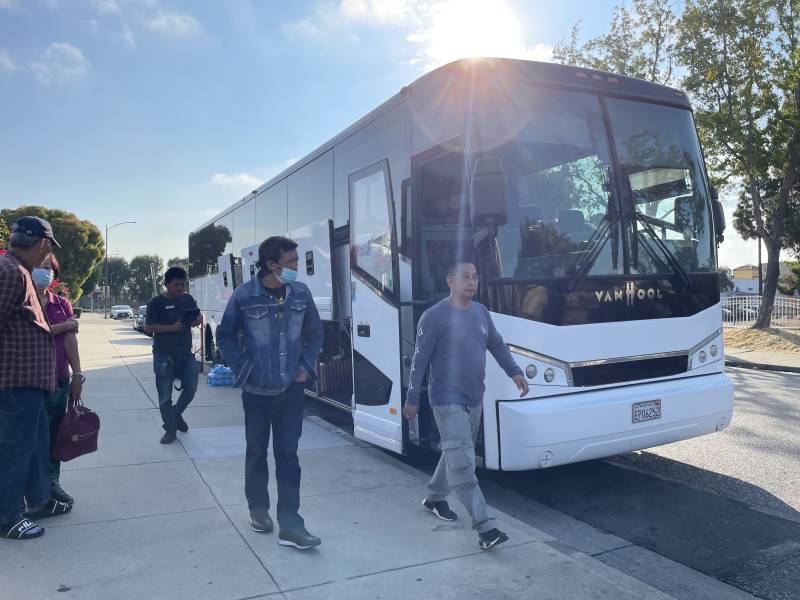
Like Greyhound, but Vietnamesified
The Xe Đò Hoàng bus company started when its founder, Linh Hoàng Nguyễn, saw an opportunity. Around 700,000 Vietnamese Americans live in California. San José and Little Saigon in Orange County anchor the community, much like Hanoi and Saigon, the historical northern and southern capitals of Vietnam.
In the late 1990s, Linh, a former refugee-turned-professional driver, voluntarily helped other Vietnamese people navigate airport check-ins at Orange County’s John Wayne Airport. For many immigrants who didn’t “know the way to San José,” the airport and the language barrier were overwhelming. There had to be an easier way.
Linh wondered, what if he drove people himself? He started with a few vans between San José and Westminster. He charged less than Greyhound and the route was three hours faster. Eventually his company expanded into a fleet of tour coaches. By providing folksy service, Vietnamese-speaking staff, familiar entertainment and a free bánh mì, Linh created Vietnamese #vanlife or #buslife culture.
With enough food to last us the six-hour ride, my daughter and I settle into our seats. We roll down Highway 101, past Gilroy’s garlic fields. Spanish, Tagalog and Chinese conversations intersperse with Vietnamese.
Behind me, Hiền Nguyễn, 73, marvels at the low prices for avocados at roadside stands. I’m also a farm stand aficionado, and we quickly fall into a conversation about fruit prices. Hiền smiles approvingly at my daughter. She tells me she and her husband, Ly, don’t feel confident driving the 400 miles to see their grandchildren. They’d rather relax.
Today’s trip is relatively quiet except for opera drifting from someone’s phone. On-board entertainment depends on the driver’s mood. The bus line is known for playing back-to-back episodes of "Paris by Night," the blockbuster Vietnamese variety show, from the drop-down screens, but today, driver Tùng Đỗ lets riders choose their own entertainment.
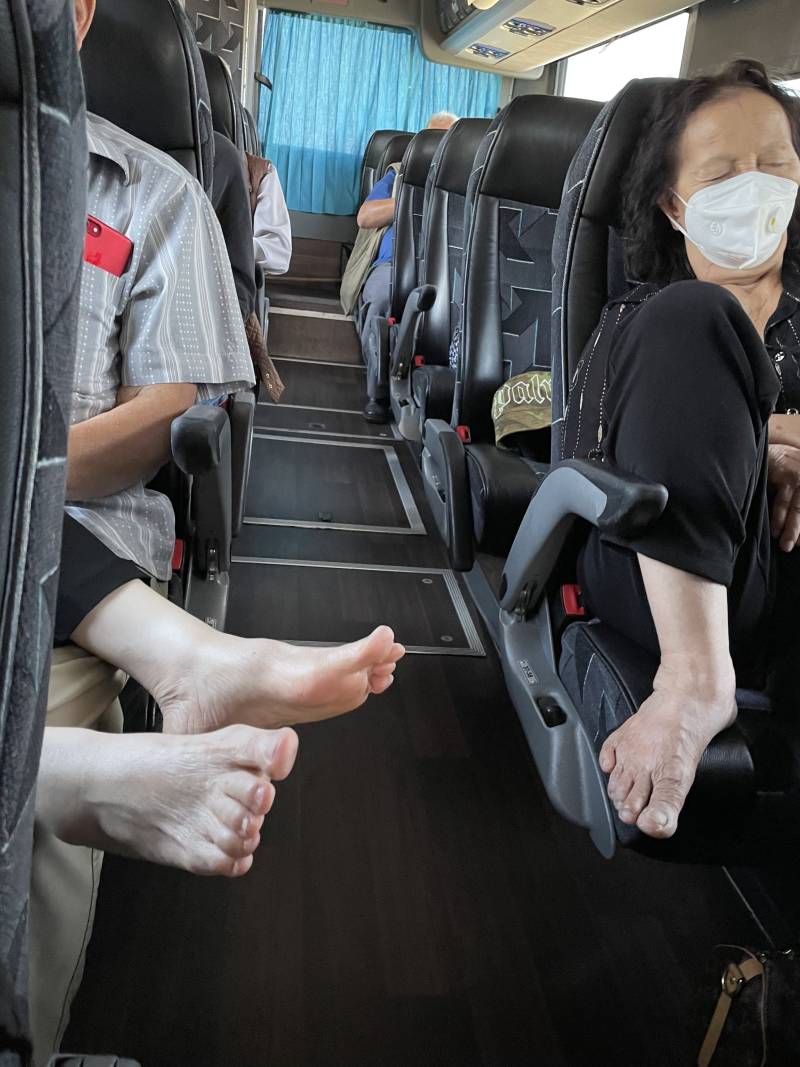
Andrew Lê, 18, has on earbuds and scrolls through his phone. He’s unfazed that the woman behind him has propped her bare foot on his arm rest. He just graduated from high school and is on his way south to meet cousins at an electronic dance music festival. He says he looked into a train, but didn’t feel confident he could manage all the transfers. Plus, the journey would have taken over 12 hours. His mother booked him this trip and sent him with a bánh mì.
We pass the Harris Cattle Ranch, California’s largest feedlot, outside Coalinga. I’m thankful for the aggressive air-conditioning that quickly circulates air. Gentle snoring mixes with the hum of the bus engine.
Hiền, smiling, passes me an adorable cluster of apple bananas. The fruit is firm and fragrant, and tastes faintly of pineapple.
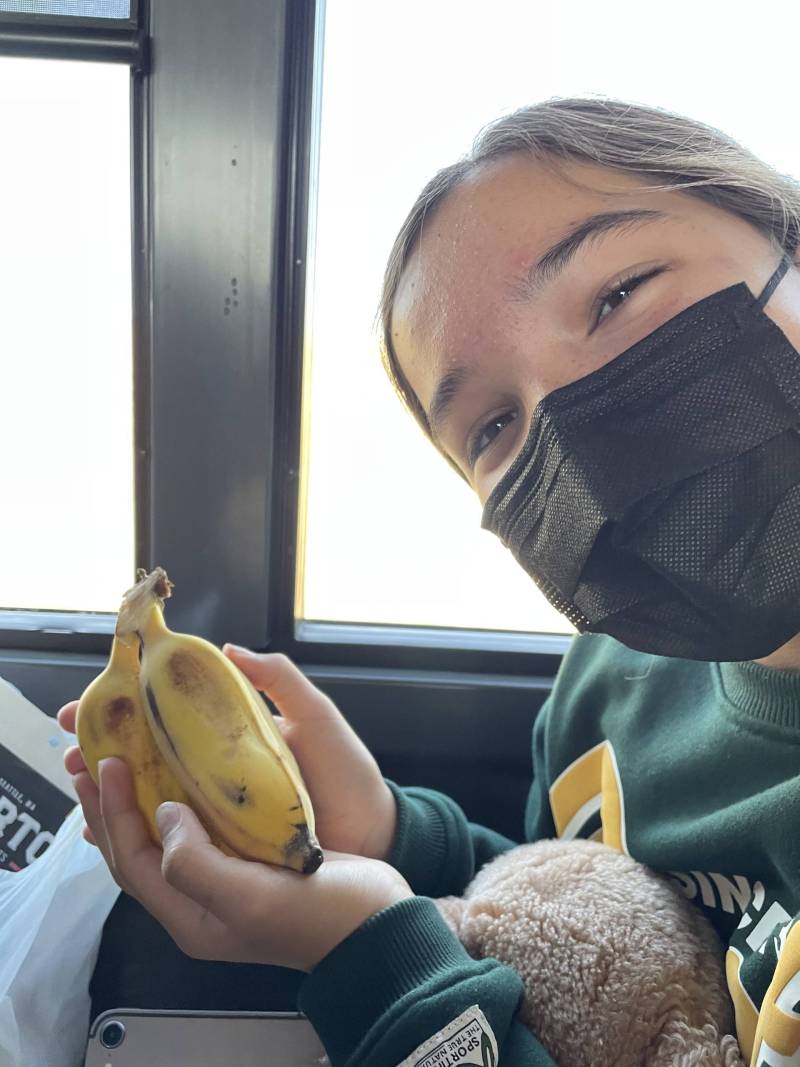
Surviving pandemic challenges … and attempted murder
Like many businesses, Xe Đò Hoàng had to make adjustments during the pandemic. When indoor dining was prohibited, its long tradition of providing free lunch ended. What was once many buses a day became a single bus in each direction. But customers are coming back. More recently, a second afternoon run resumed on weekends, but rising gas prices have also cut into the company’s profits. A ride is now $50, but when I rode, staff made accommodations for seniors who were used to previous pricing.
Employees tell me Xe Đò Hoàng has leaned on its same-day shipping service to maintain income. The flat-rate shipping — $5 for small items to $20 for items up to 60 pounds — is cheaper than FedEx. A scale was available, but no one really seemed to bother weighing anything. I counted eight tropical fruit trees by the cargo bay. I don’t know how they stuffed them inside.
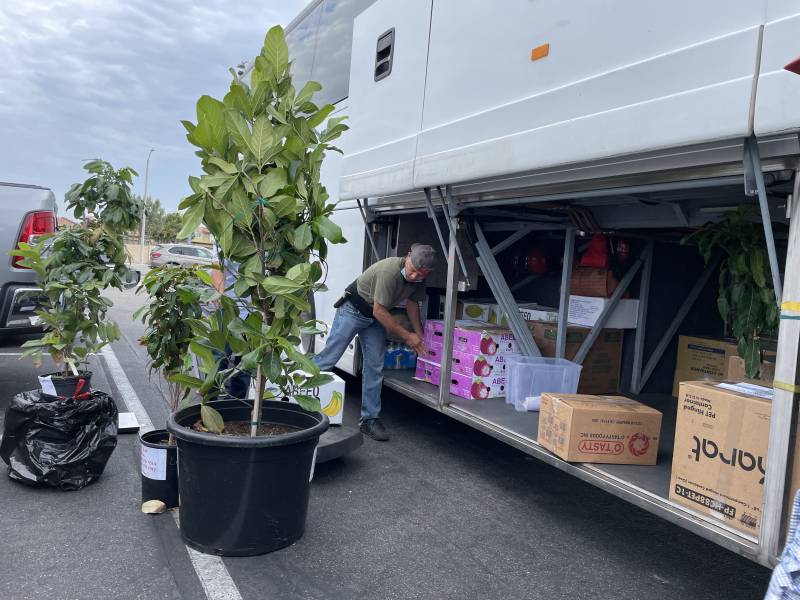
Besides weapons, explosives, and illegal substances, only a few items are off-limits. While staff discourage odiferous foodstuffs like fish sauce, durian or jackfruit, I spotted a jackfruit in the shadows of the cargo bay. It must have weighed 40 pounds.
Xe Đò Hoàng bus company has survived previous existential challenges. In the early aughts, business was so lucrative, copycats pushed owner Linh Hoàng Nguyễn into a “bus war.” What happened is part of California Vietnamese lore: Prices dropped. Someone torched two buses. A driver was assaulted. Then came the attempted murder.
On July 23, 2005, as Linh got into his car at his home in Fountain Valley to go to work, a gunman fired six shots through his window. Linh took bullets in the neck, shoulder blade and arm. He was admitted to UC Irvine Medical Center’s intensive care unit.
News of the attempted killing ricocheted throughout Vietnamese communities as far as Australia and France. And people rallied around Linh. Two weeks after being shot, he was out and about, on a thank-you tour through Little Saigon.
Following the shooting, business actually improved. An investigation that spanned Northern and Southern California concluded that the incident was an attempted murder for hire, ordered by a competitor. Eventually, in 2009, three hitmen were convicted.
Today, Linh is on top again, one competitor after another gone.
Vietnamese #buslife
The Xe Đò Hoàng is a vital part of the community: Linh’s buses have given free rides to political protests. Newspapers and specialty food vendors use the bus for their north-south distribution network. During Tết, the Lunar New Year, families ship their loved ones gifts. The company sponsors an annual contest called “Writing About America,” with essays that include meditations on riding the bus.
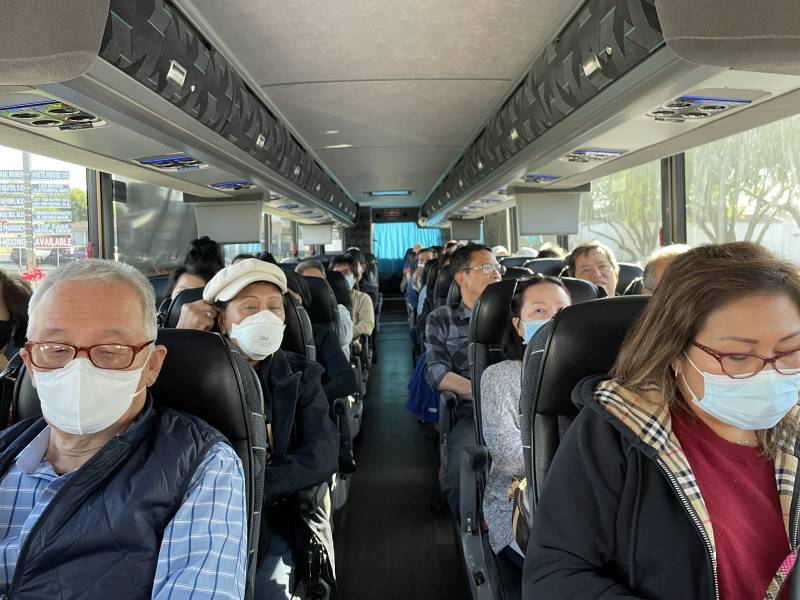
Even Vietnamese in Vietnam know about the bus. YouTubers document their American vacations on the Xe Đò Hoàng on channels like “Khánh Nguyễn’s American Life” and “The Lady Who Sells Phở.”
Outside, a cluster of umbrellas in rainbow colors shade fieldworkers. I keep time by watching a young man ahead of me struggle to sleep. Every few minutes, his head drifts precariously into the central aisle. He then straightens his neck, but eventually his head slips down again. A Buddhist nun drinks soy milk directly from a half gallon carton.
A Tupperware container suddenly materializes over my shoulder. It’s Hiền again, and this time, she’s got homemade xôi vò. Xôi vò is sweet rice dusted with mung bean powder and a hint of coconut. It was my favorite childhood food. Hiền’s topped hers with thick matchstick slices of chả lụa, which looks like mortadella steamed in banana leaves. She hands me a package of disposable utensils. I dig in.
During the only break at the Buttonwillow Travel Center outside Bakersfield, elders stretch in the parking lot.
Next to a businessman who doesn’t want to be disturbed is Tsui-Ching Kim, 67. By her count, she’s ridden the bus at least 30 times in the past decade. She lives in Los Angeles, but visits her son who works in the Bay Area. There’s the Chinatown Bus, which caters to Chinese people like her, but she still prefers the Xe Đò Hoàng.
“Because I know the driver. He is a good driver,” says Tsui-Ching.
Tùng Đỗ, the driver, scarfs down his lunch: bánh cuốn, a rice-paper crepe filled with ground pork. He’s been a driver for 30 years, six for Xe Đò Hoàng.
“I drive because I love this work,” says Tùng. “If you love your job, then you can do your job well and keep going.”
It’s a family calling. Before 1975, when South Vietnam fell to the north, his grandparents had a similar business shuttling passengers from Saigon to the resort town of Đà Lạt.
The bus is already rolling again when a group runs across the parking lot to board. Xe Đò Hoàng has a reputation for being punctual. Tùng stops to let the stragglers back on. They’re out of breath, laughing and holding their bags of Popeyes fried chicken.
Echoes of home
We pass oil donkeys on flat scrubland. What looks like a concrete-lined river is the California Aqueduct, which collects water from northern rivers to distribute to the rest of the state. Climbing the San Emigdio Mountains, we pass Pyramid Lake, a major pumping station, then descend to the Los Angeles Basin.
Hiền — my friendly auntie who keeps feeding me — and her husband say the mountains remind them of Đà Lạt. Once called “Petit Paris,” Đà Lạt has a kind of mythical quality for many older Vietnamese. It’s 5,000 feet above sea level and surrounded by pine trees. In the past, it was a getaway for French colonialists, artists and newlyweds. It seems anytime there are trees and a mountain, an elder will say it looks like Đà Lạt. I squint at the Six Flags Magic Mountain theme park and try to relate.
After brief stops in LA’s Chinatown and El Monte, and more than five hours on the road, someone decides now is the time to crack open some fish sauce.
“Sister, please close it, you can’t use fish sauce on the bus,” says Tùng, averting a potential disaster. “The rules are the same: fish sauce, salt sauce, please close it.”
Forty-five minutes later, we arrive at ABC Supermarket in Westminster. Tùng helps a woman with a cane disembark. Family members crowd to collect relatives and cargo.
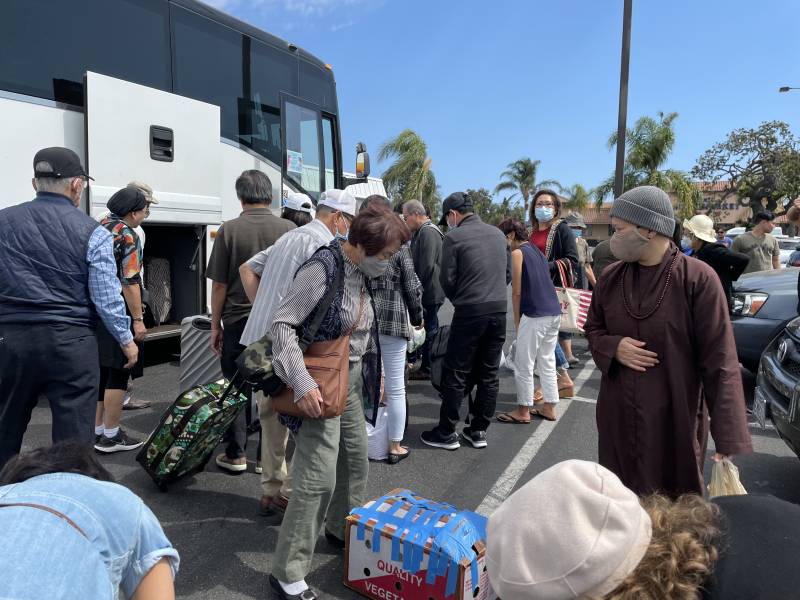
The corner of Magnolia Street and Bolsa Avenue does not have summer getaway vibes. But I’m not in Little Saigon to hang out at the beach. I’ve got a list of food to eat.
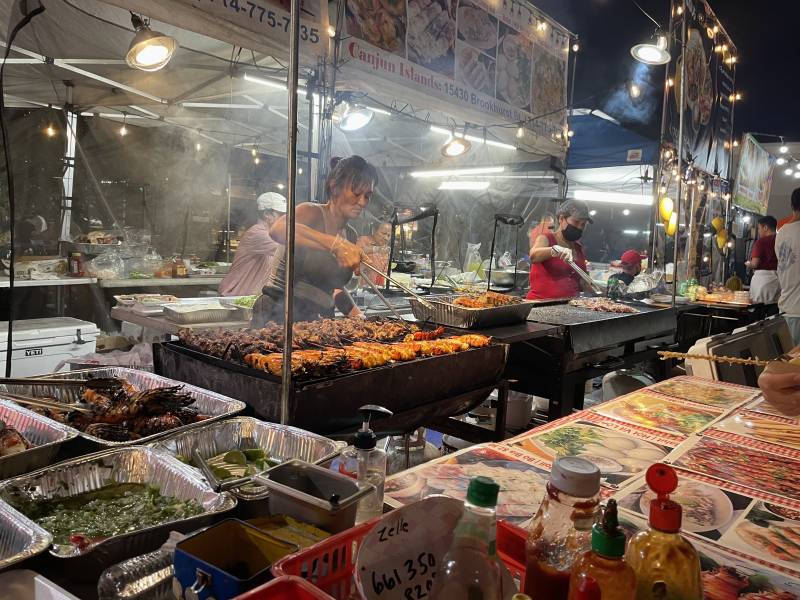
This year, Merriam-Webster added “bánh mì” to its lexicon. I think of the sandwich as a kind of Vietnamese gateway food. In its own way, a ride on the Xe Đò Hoàng feels like traveling to a new place that also somehow feels familiar — kind of like looking at a California amusement park, and swearing you’re in Đà Lạt.
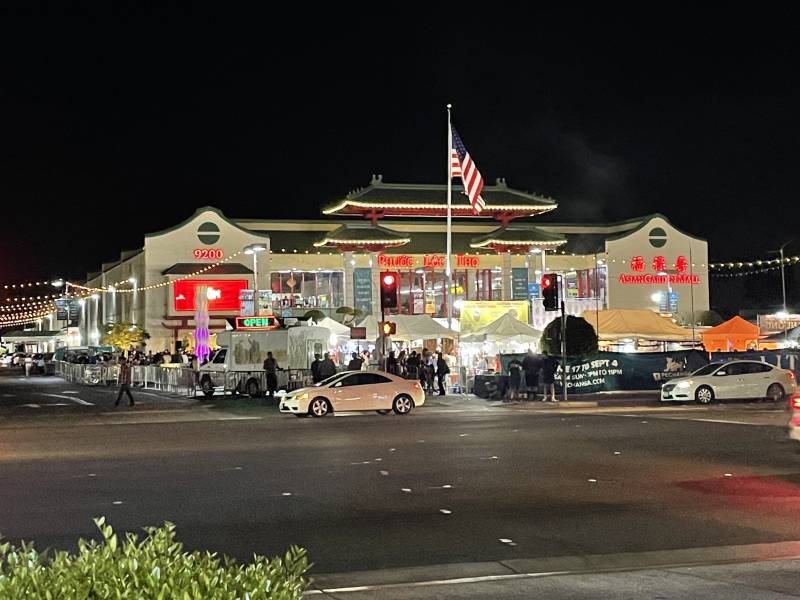
If you go:
- If you purchase a bánh mì to eat later, ask to have your pickled veggies/herbs/chilis bagged separately from your baguette filled with meat and seasonings. That way your bread will not get soggy and the veggies will retain a perfect cold-crisp crunch when it’s time to eat.
- Giò Chả Đức Hương has a polarizing reputation. Not to be confused with a nearby sister location that sells one of the most popular bánh mì in San José, this deli sells only the chả lụa, among other ingredients, to make your own bánh mì. Relatives from Houston would bring food back home from this store. However, the customer service is brusque.
- Brodard is famous for its nem cuốn. The rice-paper wrapper for spring rolls quickly gets dry, brittle and chewy. Supermarket rolls suffer from this problem. But with an entire side of the kitchen continuously devoted to rolling up nem cuốn, you know that the rolls here will be fresh.
- Cool Tea Bar in San José is part of a Taiwanese chain. Try their roasted milk tea with soft sương sáo (grass jelly). Grass jelly is made from the mesona herb and has a faintly bitter taste that prevents drinks from becoming cloyingly sweet. The smoke-colored grass jelly here is homemade, with a soft silky texture that no canned jelly can duplicate.
- Nếp Cafe is a coffee and brunch spot by day and a restaurant called Gem by night. Vietnamese coffee is becoming more ubiquitous, but what about cà phê trứng, egg coffee? Their egg coffee, originally from northern Vietnam, is not what I expected (thankfully there was no goopy yolk oozing in my coffee). Egg yolk is whipped with condensed milk into an airy froth. It tastes like liquid tiramisu.
